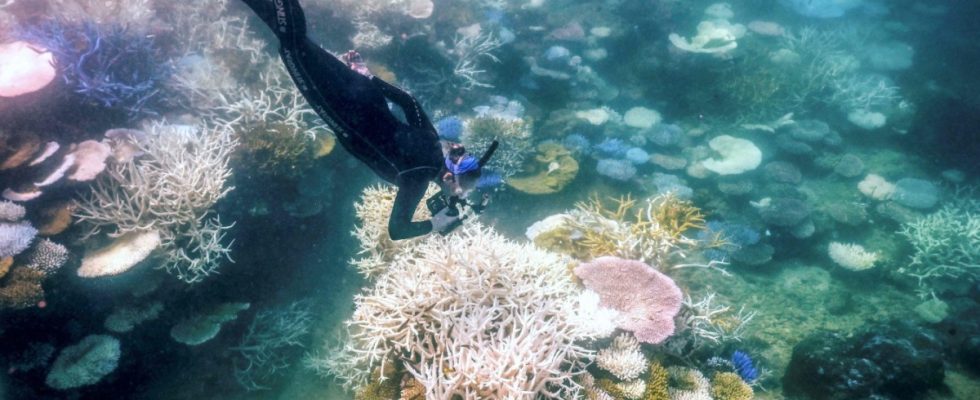“It’s absolutely heartbreaking,” says marine biologist Selina Ward. She has been researching the Great Barrier Reef off the coast of Australia for around 30 years. That’s the case with every coral bleaching event, “but with this one” – she furrows her eyebrows, swallows, smiles – “I’m really struggling with it.” Ward can be seen in a video, that the British daily newspaper The Guardian published. Behind her you can see the Pacific Ocean, and the corals in it are dying at this moment. The The US Atmospheric Administration (NOAA) speaks of thisthe world is currently experiencing the fourth global mass coral bleaching event in history.
Australia is far away, and coral reefs seem to be something for your next vacation, white corals an excitingly morbid underwater landscape. You are none of these things. In February 2024, the European weather service Copernicus reported that for the first time global warming had averaged 1.5 degrees Celsius above the reference period for twelve months.
The Intergovernmental Panel on Climate Change (IPCC) stated in 2018 that the majority of coral reefs worldwide would be lost if there was a warming of 1.5 degrees Celsius. This could happen now. In both the Northern and Southern Hemispheres, NOAA documented significant coral bleaching from February 2023 to April 2024. The researchers expect more reefs than ever before to be affected. Bleaching has been confirmed in 54 countries, territories and local economies, according to NOAA. Corals provide a home for fish, indirectly feed millions of people and protect coasts from storms. Economically alone estimated the international Global Coral Reef Monitoring Network the value of global coral reefs to $2.7 trillion annually in 2020.
“We’ve entered the disaster movie,” said Ove Hoegh-Guldberg, a professor of marine science at the University of Queensland, the New York Times. In Selina Ward’s video you can see that the underwater landscape has lost all color. Fish scurry through white coral branches, a turtle hides under a white arch, white tentacles sway in the current. The bleaching reaches depths of up to 18 meters, according to the Australian Marine Conservation Society, a foundation. Ward says coral species that are normally resistant are being affected and some are already dying, although this usually doesn’t happen for weeks or months. Terry Hughes, coral researcher emeritus at Australia’s James Cook University, has published a map with data collected so far on the X network, formerly Twitter. Corals that are still unbleached are marked blue here, but hardly any point is blue. Hughes told this Guardianthe current phenomenon is “the most widespread and severe mass bleaching and mortality event ever recorded on the Great Barrier Reef.”
Corals are not plants, but tiny animals that live in communities. The polyps have a sac-like body and a mouth. Tiny sea algae live in their tissue, giving the animals energy and color. Corals build a limestone skeleton around themselves to protect their delicate bodies. Heat causes sea algae to die; As a result, the corals starve and only their calcium skeleton remains. The consequences of this are difficult to predict; countless species depend on living corals for food or protection. Researchers around the world are therefore trying to breed coral species that can withstand higher water temperatures.
The water off Florida was up to 38 degrees Celsius in July 2023
Global ocean temperatures have been exceptionally high since 2023. In March 2024, a new all-time record for global ocean surface temperature was set at 21.07 degrees Celsius. This is an average value; locally the water can be much warmer: in July 2023, a bathtub-warm 38 degrees Celsius was measured off Florida.
In principle, it is not surprising that the seas are heating up. Human-caused emissions of greenhouse gases such as carbon dioxide ensure that more thermal energy is retained on Earth. About 93 percent of this excess heat is absorbed by the oceans.
What is surprising to researchers, however, is the current pace of warming. The ocean temperatures in 2023 were 0.25 degrees Celsius above the previous record in 2016. If a record value was previously exceeded, then by a maximum of 0.1 degrees, as stated in an analysis by scientists on the platform The Conversation is called. One reason for the extraordinary current jump is likely to be the climate phenomenon El Niño, which began in early summer 2023. However, the climate phenomenon usually only becomes noticeable in the second half of the year. By this time, ocean temperatures were well out of line in 2023.
Researchers are therefore increasingly discussing other factors: for example, the eruption of the underwater volcano Hunga Tonga-Hunga Ha’apai off the Pacific island of Tonga in January 2022 could have played a role. This released large amounts of water vapor into the atmosphere, which acts as a powerful greenhouse gas. In addition, container ships have been emitting fewer sulfur particles, which have a cooling effect on the atmosphere, for several years now. If the air becomes cleaner, this cooling effect disappears. However, these effects have not yet been sufficient to explain the anomalous heat, NASA climate researcher Gavin Schmidt admits in the specialist magazine Nature.
The heat in the Pacific could ease in the next few months as El Niño is already weakening. In the Atlantic, however, the heat could last until September.
This is likely to affect not only the corals, but also people: Experts appreciatethat this year’s hurricane season could be unusually strong due to the high temperatures in the Atlantic.
The Potsdam Institute for Climate Impact Research classifies the death of coral reefs as a tipping point in the climate system. This means that the situation can remain stable for a long time, but then change quickly and then threaten other ecosystems. There is a risk of a domino effect. “It’s about time,” says Australian marine biologist Selina Ward. “It’s time to act and there are no more excuses.”

